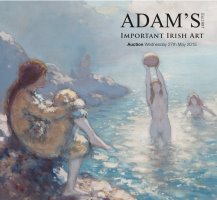
 50
Louis le Brocquy HRHA (1916-2012)
Figures in a Tudor Garden
50
Louis le Brocquy HRHA (1916-2012)
Figures in a Tudor Garden
Oil on board, 19.5 x 15 cm (7½ x 6”)
Signed. Signed again, inscribed with title and dated (19)’56 verso.
While
Figures in a Garden
or
Figures in a Tudor Garden (1956)
as it was also titled, can hardly be de-
scribed as colourful, this little painting, nonetheless, marks an important transition in Louis le Brocquy’s
work, leading in the opinion of the critic, Herbert Read, to his first truly original work. For the previous
five or six years (his Grey Period), le Brocquy’s work had been characterised by a ruthless elimination
of colour from his palette. The period is most notably represented by his Venice Biennale Prize winning
painting
A Family
from 1951, in which the only passage of colour in an otherwise almost monochrome
painting is seen in a small bunch of flowers in the hand of a child. The grey period reflects a time when
Europe was struggling to shake off the effects of a terrible war, and the world faced the new challenge
of the Cold War and the threat of nuclear weapons. By 1956 things had begun to lighten a little not just
for Europe, but for the artist himself. In that year he met Anne Madden, the painter who was to become
his wife two years later, and the austerity of his grey period began to give way to something more joyful,
seen most particularly in paintings such as
Children in a Wood (1954)
and later his procession pictures
which have a rare sense of playfulness and joy.
Figures in a Garden
, does not suggest such playfulness. Instead it reveals the artist’s ongoing anxieties
about existence, soon to receive further exploration in his white paintings, where the single hovering
presence of a human figure, defined by its shadow, rather than its substance is presented in thick white
pigment against a white ground. But for a short interval between these two important periods of his work,
le Brocquy allowed himself to re-introduce colour into his painting and to think beyond the extremes
of his grey and white periods.
Figures in a Garden
may owe something to the influence of the English
painter Keith Vaughan (1912 -77) with whom le Brocquy shared a number of preoccupations in the 1940s
and ‘50s. They were both committed to the human body, although Vaughan’s were almost exclusively
male, they were both influenced by Cubism and abstraction while remaining figurative, they both liked to
present their human figures against a flattened picture plane and on this occasion for le Brocquy, their
palettes are very similar.
There is nothing comforting or seductive about the garden in le Brocquy’s painting. The face of the moth-
er figure with her elegant long neck and smart headdress is directed straight out of the picture, although
her eyes appear unseeing. She is flanked by the merest suggestion of a child in a pointed hat and a third
figure, a woman kneeling on the ground wearing a stiff pointed collar or ruff. There is nothing to suggest
that these figures share anything other than a common place and a common time.
Catherine Marshall, May , 2015
€10,000 - €15,000



















